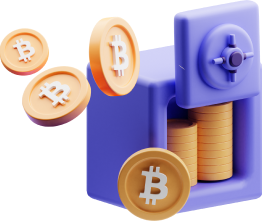What is Crypto?
Cryptos are Virtual Digital Assets based on Blockchain Technology. They can be transferred from one party to another without the help of middlemen. They are not issued by any government entity but are generated through a process called mining.
Cryptos are mined and managed by a Distributed Network of computers. This network of computers makes the Blockchain.
The first Crypto to be launched was Bitcoin, in the year 2009. Since then, there have been over 10,000+ cryptos.
Traditional currencies like INR and USD are used within a country’s jurisdiction and are bound by Government rules. Cryptos on the other hand can be used globally. Each Crypto works on its Blockchain network spread across many regions or sometimes many countries.

If you are someone who is intimidated by these questions, trust us, we will help you get to the bottom of the subject in this article.
Cryptos are generated through a process known as Mining. This is similar to mining Gold or Silver, but instead of using earth as a resource, Cryptos are mined through a process called the Consensus mechanism. A consensus mechanism is a method through which a transaction on a Blockchain ledger is validated by all the members of the network.
Now that you are acquainted with the basic terminology of Blockchain workings, Let us take Bitcoin as an example to understand mining.
We have stated earlier in the article that all transactions of a Crypto are recorded on a Distributed Ledger known as Blockchain. Each transaction has the details about the sender, the receiver, and an encrypted Digital Signature of the transaction.
Miners on the network compete with each other to decode the digital signature of the transaction, and the correct decrypted version is known as the hash function. The one who does it first is rewarded with Bitcoins. These transactions are recorded on a block and each Block address is linked to the previous Block on the network, thus making a Blockchain. This consensus mechanism to mine a Bitcoin is known as Proof of Work.
There are several consensus mechanisms like Proof of Stake and Proof of Authority, and each consensus mechanism works differently. The point to be noted is that these mechanisms are there to ensure the Validity of transactions, remove middlemen and avoid Counterfeiting of Coins.
Types of Cryptos

Bitcoin
Bitcoin is the first crypto asset to be created. It was created in the year 2009 by an institution or person who goes by the name Satoshi Nakamoto. Bitcoin was proposed as an alternative to Fiat Currencies. In the wake of the 2008 financial crisis with the loss of trust in Financial Institutions, a non-corruptible asset class was needed for people to use as a store of wealth. Thus, bitcoin was invented.
Bitcoin runs on an open-source Blockchain Ledger, which can be viewed by anyone around the world. All transactions of Bitcoin ever done can be viewed on this Blockchain. These transactions cannot be erased and once appended they are on the Blockchain forever creating a non-corruptible ledger system. Few characteristics of Bitcoin which makes it a formidable asset class are
1. Bitcoins are finite
There will only be 21 million Bitcoins. The Bitcoin Blockchain protocol is designed in such a way that no more than 21 million Bitcoins can be mined. This makes Bitcoin scarce, unlike Fiat currencies which are in abundance. Scarcity coupled with growth in demand increases the value of the asset.
2. Incorruptible system
The Blockchain system which powers Bitcoin is one of the most novel ways of Financial transparency. Every transaction can be seen along with the addresses of the parties participating in the transaction. These transactions cannot be erased thus making the system fully proof.
Altcoins
Coins alternative to Bitcoin are called Altcoins. The technology which enables transactions of these coins is the Blockchain technology similar to that of Bitcoin. But each coin has its use case.
The most famous Altcoin in the Crypto market is Ether ( ETH). Ethereum Blockchain which powers Ether enables smart contract agreements. These agreements are code enabled and do not require a third party.
Other well-known Altcoins are Solana, Cardano, Binance Coin, etc.


Stable Coins
These are coins that are pegged to a Fiat currency. For example, USDT is a Crypto asset that is pegged to the United States Dollar. The value of 1 USDT is equal to 1 USD. Stablecoins can be a less volatile option for people interested in investing in the crypto world. They come with the favourable aspects of security, transparency, and transferability of the Cryptos coupled with the stability of Fiat Currencies.
Tokens
Coins and Tokens are often used interchangeably, but the two are very different. Crypto Tokens do not have their own Blockchains whereas Crypto Coins do. For example, the Basic Attention Token ( BAT) is a token that uses the Ethereum Blockchain for all its transactions. As setting up a Blockchain network is difficult and energy-intensive, the BAT founders have decided to focus on their product ( The Brave Browser) and use the Ethereum Blockchain for all transactions.

How to Buy Crypto In India
The easiest way to buy and sell Crypto is by using a Crypto exchange. Crypto exchanges are platforms where buyers and sellers in the Crypto market interact.
Zebpay is India’s leading Crypto exchange with close to 100+ Cryptos. Zebpay allows users to buy, sell , lend and exchange cryptos with ease. Close to 98% of funds are stored securely in Multisig cold wallets. Our state-of-the-art security systems and easy-to-use interface help you invest securely with the click of a button. All you need to do is to create an account on the Zebpay app or website with a valid phone number and email address.
You can read more about how to buy Bitcoin here.
How to Store Crypto

Exchange Wallets
These are wallets provided by a crypto trading platform. Example: ZebPay wallet. Users can store their Cryptos in the Zebpay wallet and can use the assets to trade instantaneously.

Cold Wallets
Cold wallets are hardware wallets that can store your cryptos. They are inaccessible to the internet and can be sealed with secure keys. Ledger Nano X, Ledger Nano S, and Trezor Model T are some of the best-known Cold wallets.

Hot Wallets
These are digital wallets using which Crypto transactions can be carried out. They are easy to use when compared to a cold wallet, as your Crypto is readily available in the wallet to make transactions. MetaMask is a famous hot wallet used to buy Ethereum-based ERC 20 tokens. These wallets can be used as extensions to your browser.

Paper Wallets
Paper wallets are literally what they mean. You can print your public and private keys on a piece of paper. The keys are displayed through a QR code. Transactions can be carried out by scanning the QR code through a mobile device or providing the public key to whoever wants to pay you. Paper wallets were famous before digital wallets caught fame but are not used now as paper is fragile, and the risk of losing a piece of paper is very high.
Traditional Currencies vs Crypto
Crypto assets are decentralised whereas Traditional Currencies are issued by the Reserve Banks / Federal Banks of countries
Crypto assets are regulated by the rules of the Blockchain whereas Fiat currencies are regulated by the rules of Federal Banks and Governments
Crypto assets can be used as a medium of exchange in a few countries, but in most nations, Cryptos are used as investment options. Traditional currencies are primarily used as a medium of exchange and are often found to be poor wealth creators as they are exposed to Inflation
Few Crypto assets like Bitcoin have a finite supply which makes them scarce. Traditional currencies on the other hand are not backed by a commodity and can be printed as per requirement.
Cross-border payments are quicker and more economical for Crypto payments when compared to Fiat transactions

Benefits of Crypto

Cryptos are backed by the power of Blockchain – Blockchain technology is a powerful tool on which all Crypto assets are mined. It has transformative applications which are already seen in industries such as Decentralised Finance and Metaverse. Blockchain technology is helping innovators create remarkable applications in various fields.
The transactions are transparent – All transactions ever made can be viewed on Public Blockchains which makes Cryptos transactions fully transparent
Financial Inclusion for people from around the world – In many parts of the world, Fiat currencies have lost their value due to excessive inflation and large-scale value erosion. Crypto assets can be a boon to these nations. Anyone with a cell phone and internet access can be an active Crypto holder
Easy to make cross-border payments – Cross border Wire transfers of Fiat Currencies are time taking and expensive. Crypto transactions on the other hand are secure, quick, and stress-free. All the sender needs is the public key of the recipient to send Crypto assets.
How to avoid Crypto Frauds

Wallet Security
Always ensure that your wallets are secure and never share your private keys with anyone. ZebPay has a very secure system to protect investor assets. 98% of ZebPay’s assets are stored in Multisig Cold wallets, which are remote and secure.

Beware of Scamsters
ZebPay never asks users to share any information via email, phone, or Social Media. Beware of impersonators who pretend to represent the company. There may be no recourse from loss in such transactions.

Free money scams
Never give into scams that promise to multiply your wealth. No market assets can promise assured returns, and it’s important to note that there is a risk associated with Cryptos which are subject to market conditions.
Are Cryptos legal in India?
Crypto assets are not illegal in India. The legality of crypto assets has been a subject matter of discussion by lawmakers, but currently, there is no ban or any prohibition or specific regulation on the use of crypto assets in the country.
In 2018, the Reserve Bank of India (RBI) vide its circular no. RBI/2017-18/154 BR.No.BP.BC.104/08.13.102/2017-18 dated April 6, 2018 (the “RBI Circular”) had imposed a prohibition on entities regulated by RBI on dealing in virtual currencies. However, the Hon’ble Supreme Court, in the matter of Internet and Mobile Association of India v. Reserve Bank of India, lifted the said prohibition and set aside the RBI Circular.
It is to be noted that recent amendments to the Income Tax Act, 1961 include taxation provisions applicable to cryptocurrencies. Newly introduced Sec 2 (47) (A) defines Virtual Digital Asset (VDA) which includes cryptocurrencies, NFT, and any other digital assets as notified by the government.
A regulatory framework on crypto assets is still awaited in India, and they are unregulated in India as of now.

Is it safe to invest in Crypto?

No investment option assures guaranteed financial returns. It is the same with Cryptos as well. Cryptos and NFTs are unregulated and can be risky. Investors should do their due diligence before making a buy or sell decision. It is advisable to read whitepapers on Cryptos which give detailed information about the coin philosophy and use cases.
As far as what Crypto to buy, only you can make that decision. We at Zebpay strive to provide information and the latest updates in the Crypto industry to help our investors make sound decisions.



